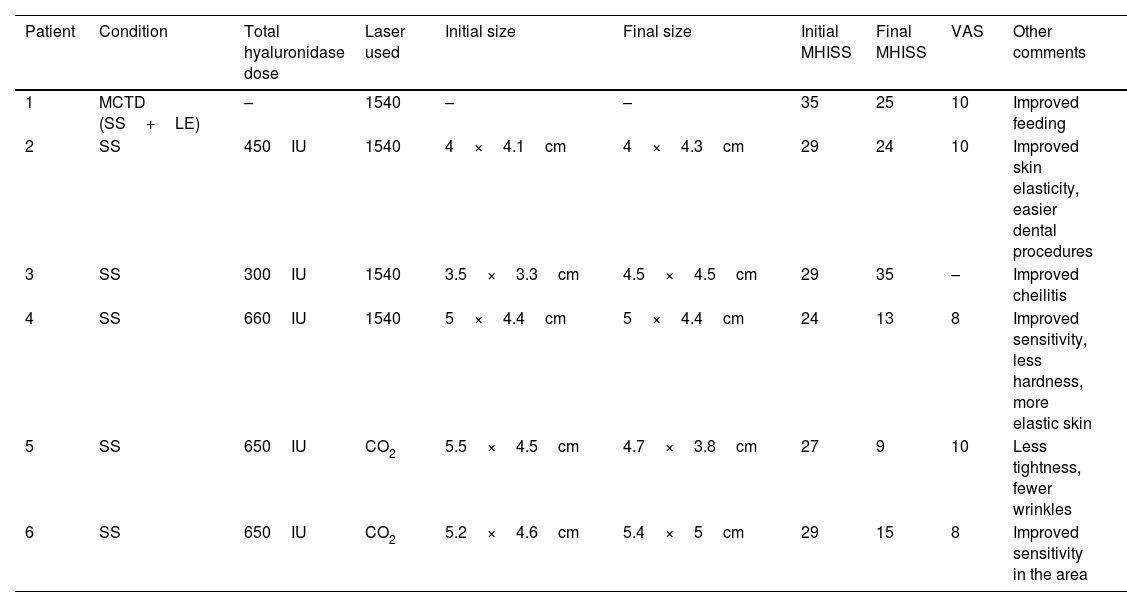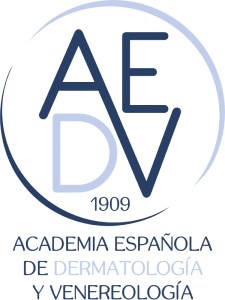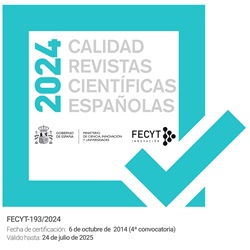Microstomia is a common symptom in patients with systemic sclerosis (SS). Currently, there is no specific treatment, and it significantly impacts these patients’ psychological well-being and quality of life.
In recent years, some very promising treatments have emerged, such as carbon dioxide (CO2) laser or the use of hyaluronidase. However, there is very little evidence regarding these. We are not aware of the use of non-ablative fractional laser in these cases or the combination of these therapies. We describe the cases of 6 patients with SS-related microstomia in whom the combination of hyaluronidase plus ablative or non-ablative fractional laser led to a significant improvement in oral aperture and high patient satisfaction.
Six women with SS and microstomia underwent subcutaneous hyaluronidase infiltration in small aliquots (approximately 5–10 units), using a 32 G needle periorally, maintaining an approximate distance of 0.5cm between each injection point. Prior to administration, a negative hypersensitivity test on the forearm was required. The doses of hyaluronidase used varied between 300IU and 660IU, depending on the case treated. Immediately after, a session of ablative fractional CO2laser (Smart-Xide DOT®, Deka, Italy) or non-ablative fractional laser (NAFL) (ICON® 1540/IPL Cynosure platform) was performed, depending on each patient's preference for the subsequent recovery time, which varies between the 2. The parameters used were variable: using maximum powers of 19W, 450ms, and 800 dwell time for CO2, and 15ms and 65J for 1540. To evaluate treatment, maximum horizontal and vertical oral aperture was measured with a ruler in centimeters, as well as its impact on quality of life using the validated Mouth Handicap in Systemic Sclerosis (MHISS) scale at baseline and 2 months post-treatment. Photographs were taken, and patient satisfaction was assessed with a visual analog scale (VAS) from 0 to 10, where 10 was the maximum score.
The patients’ characteristics are shown in Table 1. All were on immunosuppressive treatment for SS. A single session of hyaluronidase (doses varying between 300 and 660IU) and a laser session immediately after were performed. Four patients received NAFL treatment, and 2 received ablative CO2. All patients showed improvement 1 month into therapy (Fig. 1): 5 improved oral aperture and 5 achieved a significant reduction in the MHISS scale (between 5 and 18 points difference). One patient's MHISS scale worsened, but the evaluation coincided with a worsening of her underlying lung disease, which we believe may be the reason. All patients were satisfied with the treatment, with scores between 8 and 10. Additionally, patients reported improved skin elasticity, reduced tightness sensation, as well as improved self-image and ease of dental hygiene. Patients did not experience any significant adverse effects.
Patients with SS treated with hyaluronidase and consecutive laser therapy.
| Patient | Condition | Total hyaluronidase dose | Laser used | Initial size | Final size | Initial MHISS | Final MHISS | VAS | Other comments |
|---|---|---|---|---|---|---|---|---|---|
| 1 | MCTD (SS+LE) | – | 1540 | – | – | 35 | 25 | 10 | Improved feeding |
| 2 | SS | 450IU | 1540 | 4×4.1cm | 4×4.3cm | 29 | 24 | 10 | Improved skin elasticity, easier dental procedures |
| 3 | SS | 300IU | 1540 | 3.5×3.3cm | 4.5×4.5cm | 29 | 35 | – | Improved cheilitis |
| 4 | SS | 660IU | 1540 | 5×4.4cm | 5×4.4cm | 24 | 13 | 8 | Improved sensitivity, less hardness, more elastic skin |
| 5 | SS | 650IU | CO2 | 5.5×4.5cm | 4.7×3.8cm | 27 | 9 | 10 | Less tightness, fewer wrinkles |
| 6 | SS | 650IU | CO2 | 5.2×4.6cm | 5.4×5cm | 29 | 15 | 8 | Improved sensitivity in the area |
CO2, carbon dioxide; MCTD, mixed connective tissue disease; SS, systemic sclerosis; LE, lupus erythematosus; VAS, visual analog scale; MHISS, Mouth Handicap in Systemic Sclerosis.
Three patients have been followed for >5 months, with sustained improvement.
Treatment of microstomia in SS is challenging. Typically, drugs used in clinical practice aim to improve visceral problems and inflammation, but they do not improve microstomia. This sign has many implications for patients’ lives, including problems with adequate nutrition or performing regular proper dental care.
Hyaluronidase has emerged in recent years as a promising therapy because it plays a crucial role in the degradation of hyaluronic acid in the extracellular matrix. However, there are very few reports on the subject: 2 are single cases and 2 are retrospective studies with 4 and 12 patients, respectively.1–6 The number of sessions and doses used are highly variable in all of them (between 75 and 470 per session), and most have required>1 treatment session (between 3 and 5). In our series, the dose of hyaluronidase used was higher, which, along with the subsequent use of laser, could explain why improvement was seen in all cases with a single treatment session. In all described cases, including ours, improvement occurred early.
On the other hand, CO2 laser has been successfully used by authors such as Bennani et al., who performed between 1 and 3 sessions with good results.7,8 To date, we have not found any reference on the use of NAFL and microstomia. The mechanism by which laser acts is not fully understood. In a clinical trial, Taudorf et al.9 observed an improvement in the thickness and flexibility of burn scars, as well as a normalization of collagen at the histological level 6 months into therapy. Furthermore, it appears to modulate the expression of beta factor (a profibrotic mediator), resulting in a normalization of collagen imbalance. Additionally, CO2 could modulate the increase of type I collagen and VEGF expression, which is involved in initial stages of neocollagenesis.
Either one of the 2 lasers used can induce dermal remodeling, with greater effect from ablative lasers, which is why we believe their use likely offers more benefit.10 The main difference between the 2 lies in skin recovery time, which is longer for ablative lasers, leading some patients to prefer the non-ablative option.
According to our results, we believe that the combined technique can offer benefits compared to the isolated use of techniques. On the one hand, because the heat generated by the laser can help diffuse the previously injected hyaluronidase, and because the mechanism of action of the 2 techniques is different and complementary.11,12
The limitations of this study are mainly the sample size and the lack of a control group with single therapy.
We believe that combined treatment with hyaluronidase and laser is an effective and safe alternative for the treatment of microstomia in patients with SS. In our experience, it improves oral aperture, associated symptoms, and patients’ self-esteem.
Conflicts of interestNone declared.






